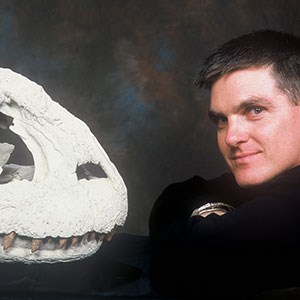Part of a series of articles titled Meet A Paleontologist.
Article
Scott Sampson, Denver Museum of Nature & Science

Vice President of Research & Collections and Chief Curator
Denver Museum of Nature & Science, Denver, Colorado
NFD Kid's Page Interview...
What is your job, and what do you study?
The bulk of my research has focused on the ecology and evolution of dinosaurs that lived in the Late Cretaceous, near the end of the Mesozoic Era. I've conducted fieldwork in Kenya, Zimbabwe, South Africa, Madagascar, Mexico, the United States, and Canada. Along the way, I've published numerous scientific and popular articles and lectured to audiences of all ages on many topics, including paleontology, evolution, and connecting people with nature. I was the primary scientific consultant and on-air host of the four-part Discovery Channel series Dinosaur Planet. Today lots of children and parents know me as, "Dr. Scott the Paleontologist," host of the hit PBS KIDS television series Dinosaur Train, produced by the Jim Henson Company. I also authored the general audience book, Dinosaur Odyssey: Fossil Threads in the Web of Life (University of California Press, 2009).
What are you working on now?
Since 2000, I've devoted most of my research efforts to heading up a project in Grand Staircase-Escalante National Monument, southern Utah. This interdisciplinary, multi-institutional project, focused on Late Cretaceous (Campanian) aged rocks, has revealed a previously unknown fauna of dinosaurs, turtles, crocodiles, and other animals that lived on a landmass known today as "Laramidia." A few of the highlights include new horned dinosaurs like Utahceratops, Kosmoceratops, and Nasutoceratops, as well as a tyrannosaur carnivore recently dubbed Lythronax ("gore king"). In addition to this project, I'm greatly enjoying my position at the Denver Museum of Nature & Science, where I work on a variety of projects aimed at promoting science literacy and connecting people with nearby nature. I'm now writing another general audience book about how to foster a connection with the natural world in children.
Where did you go to school? What were some of your favorite classes that you took?
After completing undergraduate and masters degrees in anthropology, with a focus on human evolution, I elected to return to my childhood love of dinosaurs, completing a doctorate in zoology at the University of Toronto in 1993. I greatly enjoyed courses in such topics as anatomy, evolution and paleontology, but my favorite course had the unlikely, tongue-twisting name "faunal-archaeo-osteology"; it was an intensive review of animal remains found at archaeological sites, but as part of the class we got to play with, and learn about, bones from a huge diversity of vertebrates. It was then that I truly became a "bone guy."
Was there an experience you had that made you realize you wanted to be a paleontologist?
Without exaggeration, "paleontology" was one of the first words I learned how to spell. So I knew at a very young age that I wanted to be a dinosaur paleontologist. I can trace this desire back to at least the age of four, when I visited "Dick's Dinosaur Park," just outside my native city of Vancouver, British Columbia. Those life-sized cement reconstructions of Stegosaurus, Tyrannosaurus, and others filled me with wonder, sparking my imagination and curiosity about what life must have been life in the Mesozoic Era.
What is your most memorable experience working with fossils?
Hmmmnnn. I think my most memorable experience with fossils has to be discovering the skull of a large meat-eating theropod dinosaur called Majungasaurus on the island of Madagascar. We knew before this particular expedition that a big theropod stalked the so-called "Red Island" near the end of the Cretaceous; literally hundreds of sharp, serrated teeth had been recovered as isolated finds. But no one knew what the animal looked like. So finding and unearthing the disarticulated skull was a joy I don't expect to match. The bones fit back together almost like a kid's kit, and the discovery prompted us to re-examine such things as the pattern of break-up of the southern supercontinent known as Gondwana. You never know what you might learn from a fossil.
Do you have any advice for aspiring paleontologists?
My advice for aspiring paleontologists would be to get as diverse an education as possible. There was a time when paleontologists were trained either as geologists or biologists. Today, the path most often followed by those on the cutting edge entails doing both. Learn about ecology and evolution. Learn about stratigraphy and sedimentology. Gain a solid understanding of biogeography and phylogenetics (the analysis of evolutionary family tree relationships). Don't worry about doing all the paleo courses right off the bat. There's plenty of time to specialize once you're in grad school. Oh, and learn how to be a strong writer and public speaker; we need a lots of those in science!
Last updated: September 18, 2017
